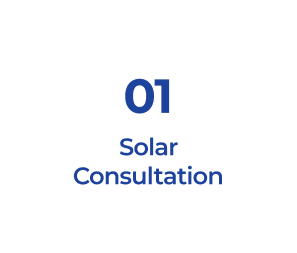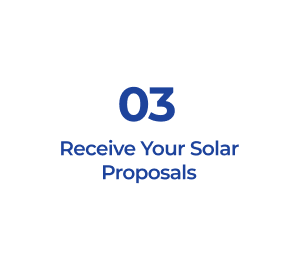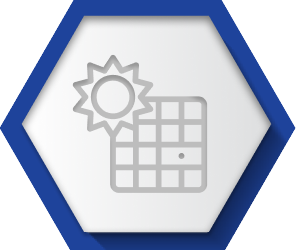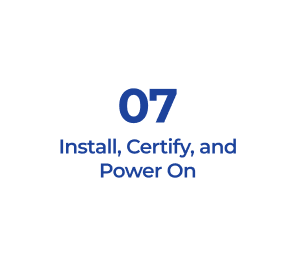We are here to help you, 24 hours a day, to ensure that you get simply better solar.

Reduce your carbon footprint

Save on your electricity bills
We are an Australian owned and operated solar retailer that has been in business for over a decade. Over that time, we have remained focused on installing top-quality solar systems at competitive prices, while at the same time, delivering exceptional customer service and support.
100% Australian-owned & operated
Australia’s most trusted Solar Retailer
Free, no obligation site visit
24-hour support
Bespoke and customised solutions
Highly-experienced with 18 years in business
There are many reasons why you should make the switch to solar but here are the main two:
Learn More
Learn More
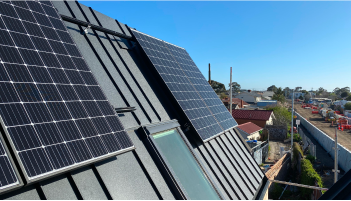
Solar
Battery
Solar + battery
Solar systems for apartments
Off grid solar systems
Ground mounted solar



Gas to electric appliance conversions
Electric vehicle (EV) chargers
Airconditioners
Heat pumps for hot water
Heat pumps for pools
Lighting upgrades
Induction stovetops
Electric ovens


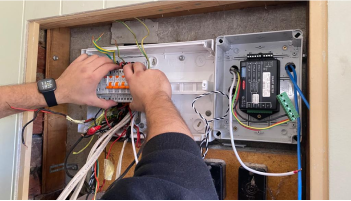
Electrical works
Switchboard upgrades
Wiring and re-Wiring
Mains upgrades


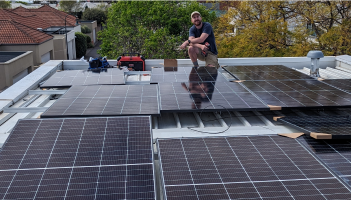
Solar systems (small and large scale)
Solar systems for retail premises
Ground mounted solar systems
Battery storage
General electrical works
Electric vehicle (EV) chargers
Lighting upgrades


Here is a graph showing both gross and net accumulated savings from a standard 6.6kw solar system over 20 years. The graph highlights the break-even point i.e. when the savings from the solar system cover the initial installation cost.

Here is a graph showing both gross and net accumulated savings from a standard 6.6kw solar system over 20 years. The graph highlights the break-even point i.e. when the savings from the solar system cover the initial installation cost.
1300 435 276

5 Stars / 41 Reviews
Home Owners
Landlords
Commercial Tenants
Apartments
Body corporates
Ground-mounted solar
Community groups
Councils

No posts found

The Ultimate Buyer’s Guide to Solar
Research well. Research early.
There are many options available nowadays when it comes to getting solar power installed at home, but the most important action that people can take is to do in-depth research and begin early. In this post, there will be many tips to going about this research to make sure that people tick all the boxes for their circumstances and find the best option for them.
Think of this as the ultimate buyer’s guide to solar.
But, where does one start? Continue below for what are some aspects of buying solar that you should consider.
The warranty
Solar providers all offer a vast array of different products. Some of these products vary in cost and quality, but the primary aspect that people need to consider is the warranty that the manufacturer offers.
Most solar energy products come with long life manufacturer warranties – often over fifteen years and a lot of them offer twenty-five years and more. Manufacturer warranties reflect the quality of the product and therefore it would be safe to think that a solar system, including solar panels and inverters, would naturally last a considerable amount of time.
A lot of people overlook their warranty, but it’s important for a reason. Solar energy products need to be reliable and made from quality materials so that they last long enough to pay themselves off and make significant savings on energy costs. The warranty needs to reflect this.
So, the best thing to do when considering solar energy products would be to look at the brand of the products and see if they are reputable and have a fantastic track record. If they do, it would be safe to invest in that brand. If there isn’t much information available, it probably helps to explain why they are cheaper to being with in the first place.
Pricing and your expectations
Related to the warranty, price, and how much a person is willing to spend on a solar panel system is the next most important aspect to look at.
In the consumer market, the rule of thumb has always been “you get what you pay for.” It is no different with solar products. If people are paying well below for a system in comparison to other similar-sized systems, they often find they are purchasing equipment that is of poorer quality or the service they receive from their solar provider is lackluster.
Making sure that the equipment is quality and the installation is professional and up to standard would seem like common sense, but many people overlook these factors when the price is lower.
Instead, it would be wise to compare the warranty periods, reviews of service they provide, and compare the solar products available to ensure that you are not buying sub-par products that may have problems later, or engaging with a service provider who may cut corners.
Furthermore, if you are looking into options to get the best value for money and reduce the overhead costs for your solar panel installation, check out our article “How Solar Can Reduce Your Electricity Costs” for more information.
Government certifications
One of the ways you can reduce the cost of getting solar installed is by accessing a rebate from the government (different states in Australia have different criteria). It is important to understand that solar energy products have different certifications based on the type of testing they have gone through in a laboratory independent of the manufacturer. This is to ensure they meet their specifications as advertised.
To qualify for a rebate – which can often mean a substantial saving – the products must have these certifications to prove their reliability, efficiency, and safety for installing at a residence or place of work.
Beware of manufacturers that have their own types of certifications. Self-assessments will be rejected and those products will be disqualified from the rebate scheme, meaning cheaper products often end up being more expensive because they cannot take advantage of a range of government incentives.
Panel size and type
The next part of the process would be to consider the size of the solar panel system and the types of panels. Over the last few years, solar energy technology has rapidly advanced and isn’t as it used to be.
In the past, limited space meant the need for incredibly efficient (and significantly expensive) “mono-crystalline” panels. However, with the advancement of technology, residents can now enjoy significant savings from solar without the need to spend heaps of money covering their whole roof with solar panels.
Even if a person has a substantial amount of roof space, they may also want to consider the size of the panels versus their energy output. A smart rule to follow would be to opt for more efficient panels and have less of them, rather than having a roof filled with less efficient panels. More efficient panels mean better use of the space available. In saying that, if a person wanted to create more solar energy, they could simply add to that system at a later date. Downsizing a solar panel system and modifying it by upgrading the panels would be costlier and more difficult in the long run. Therefore, it makes sense to make a better financial investment earlier on.
How you use your electricity
Another crucial aspect to consider when a homeowner or business owner is thinking of getting solar is their electricity use. Does the home use more electricity at night than during the day? If so, the savings made by a solar panel system won’t be as high as those using more electricity during daylight.
This is because home appliances will be using solar energy first before drawing any additional power from the grid. If there is any surplus, that is fed back to the grid and a credit is applied to the energy bill. A rule to follow would be to use the electricity generated during the day, rather than sell it back to the grid.
Generally, solar power that is consumed in the home is two to three times more valuable than selling that same energy to your energy provider. Therefore, households that use a lot of electricity during daytime hours will end up saving more money with a solar system. They also often see their investment pay itself off quicker – the average being in between three to six years.
This is in stark contrast to selling back to the grid, where people will see a return on investment within six to nine years instead.
Having said this, it is important to note that just because a person’s habits now tend towards nighttime use, it doesn’t mean that they cannot plan in the future to ensure that they use more energy during the daytime, and in turn, greatly increase their yearly savings.
A bonus tip for this would be to check the electricity bill and analyze how much energy is used every month, quarter, or more. Also, check peak and off-peak rates to gain as much information as possible to know how electricity is being utilized within your home or workplace. This will better equip the person to make smarter decisions and change habits to reap the rewards of getting solar.
Getting Solar in 2020
Even though this has been an uncertain year for many due to COVID-19, plenty of homeowners are installing solar panel systems to reduce their electricity bills and free up their finances.
If you are interested in how solar can bring you benefits while working at home during the pandemic, check out the article “The Benefits of Solar During Covid-19.”
The solar industry is still thriving during this time and the government incentives are now more available than ever to cut down the costs of getting solar. For people looking to save money and have a significant impact on renewable energy sources, now is a great time to research the options that are currently being offered.
If you’ve enjoyed this post today, please sign up for the mailing list to receive current news, information, and advice on solar power and saving money on your bills.
Understanding Solar Payback Time for Saving Money over the Next 4-7 Years
What is solar payback time?
Solar payback times is the time that it takes for a solar panel system to pay off the initial investment made. In Victoria, it generally takes 4-7 years for a solar panel system to pay itself off, after which point a homeowner can start to experience the true financial benefits associated with solar.
It is important to understand the different factors that affect the solar payback time so that you can make a smarter purchase and maximise your return on investment. These factors include:
All of the above will affect how much a person can save with solar, and inherently, impact on the solar payback time.
Solar panel system size
As a general rule, larger solar panel systems generate more electricity each year. In saying that, larger systems typically incur more sizeable upfront investments, are generally more costly to maintain, and also require more regular inspections by solar providers.
Currently, the most common system size for homes in Victoria is a 6.6-kilowatt solar panel system. This is because it is the most powerful in terms of how much usable electricity it can produce – saving you more money. A 6.6-kilowatt system has also become more cost-effective in recent years due to advances in technology.
In Australia, a6.6-kilowatt (kW) system tends to be the largest for homeowners, as it fits within the capacity of single-phase power, rather than requiring three-phase power.
Single-phase power has a limit of 6.6-kilowatts for solar power systems and will be able to supply a voltage of up to 230 volts (240 for Queensland and Western Australia) to household appliances – this is within the rang of most household devices.
Three-phase power, on the other hand, can power a solar panel system that is up to 30-kilowatts and can supply power to devices requiring 400+ volts. Items requiring this kind of power are commonly industrial machinery or commercial appliances for business and production use.
The initial cost
Depending on where you are in Australia, prices for solar panel systems can vary greatly. Nevertheless, the price of a system per kilowatt has declined by almost 40% over the last six years. When this is combined with government incentives for solar power, it makes it a perfect time to invest in solar.
As of August 2020, the average price for a solar panel system was between $1,200 – $1,600 per kilowatt. This would put the average cost of a 6.6-kilowatt system to be in the region of $9,000 in Australia – with even higher costs in areas such as Hobart or Darwin.
To make solar more affordable for residents, the Federal Government currently provides an upfront incentive for new installations through the issue of Small-scale Technology Certificates (STC). In Victoria, eligible applications can also apply for the “solar homes rebate” and “solar homes loan”, both of which are worth up to $1,850. Therefore, in Victoria, it is not uncommon for homeowners to see shorter solar payback times due to the special incentives offered by the State Government.
For more information regarding solar incentives, see our previous post titled “Solar Rebates And Incentives Explained”.
Household energy consumption
Energy consumption in the home is another significant factor which influences solar payback time.
An Australian household without gas uses an average of 5,000kilowatt-hours annually. This average would now be higher for people working from home during the COVID-19 pandemic.
Household electricity consumption fluctuates depending on the following:
The more that a household can reduce their annual electricity consumption, the shorter the solar payback period will be. It is recommended to request an energy bill breakdown from a utility provider to see how much electricity is being used daily.
The annual output of a solar panel system
The next factor which greatly influences the return of investment for a solar panel system is its annual output.
For a 6.6-kilowatt system, the average output per year in Victoria is 8,000 kilowatt-hours. This average is taking into account that the majority of homeowners will be unable to have solar panels facing in the optimum direction for power generation at all times – a feature that only the more expensive, automated systems have.
The annual output of a system is significantly affected by weather conditions and sunlight. This means areas such as Perth and Darwin are more likely to generate more electricity, having average outputs of 10,000 kilowatt-hours.
If a household can use the majority of the solar energy it produces, rather than selling it back to the grid, then this can significantly shorten the solar payback time.
Self-consumption of solar energy
Generally, households only consume a portion of the solar power they produce and then sell the rest back to the grid for the “feed-in tariff (FIT) price”. With that in mind, the cost of drawing electricity from the grid is actually more expensive than FIT prices. This means that households with a higher percentage of self-consumption will have faster solar payback times.
Smaller solar panel systems typically result in higher levels of self-consumption and faster payback times, but the overall savings are generally lower due to generating less solar energy. Larger solar panel systems, on the other hand, produce more electricity and have slower payback times, but the overall savings are generally higher.
The majority of experts agree that purchasing a smaller solar panel system to shorten the solar payback time is a “false economy” and owners of smaller systems often wish they had installed larger systems from the start.
While households vary in terms of self-consumption of solar energy, those with a 6.6-kilowatt system self-consume approximately 20-25% of the electricity generated. For people work from home or those who tend to have most of their power usage during the daytime hours, this figure will be a lot higher.
Important: Throughout the COVID-19 pandemic, Australia has seen a surge in people working from home. In saying that, solar power can be of significant benefit to those employees, especially if they can modify their daily electricity usage (to use more electricity during daytime hours, and less during the night).
If you are interested in learning more about the benefits of solar during COVID-19, read the article “The Benefits of Solar During COVID-19.”
Solar feed-in tariffs (FITs)
FIT prices are the final part of the solar payback time equation.
In places such as Darwin, the feed-in tariff is high enough that it is feasible to get an annual credit of $900-$1,200 with the power generated from a 6.6-kilowatt system. The average annual bill without solar power in that region is be between $1,300-$1,600 – meaning that a solar panel system pays for the electricity and earns a household upwards of $1,000 per year.
While the above figures are unlikely in areas with less optimal weather and environmental conditions, it is still possible to achieve close to a zero bill for electricity.
In Melbourne, the average annual electricity bill is between $1,200-$1,600 depending on age, area, and lifestyle. A 6.6-kilowatt system would make an estimated savings of $1,200-$1,300 per year based on current FIT prices. If a household modifies its habits and has a higher percentage of self-consumption during the day, these savings could increase a further 10-30%.
An investment for the future
Notwithstanding the average statistics, Victoria is in fact the second-fastest state for solar payback times due to the “solar homes rebate”. In saying that, it would only take a homeowner in Victoria between 4-7 years for their solar system to pay for itself – after that, any savings generated by the system could be considered true profits. Due to this, more and more homeowners are making the switch to solar as an investment for their future.
If you have found today’s article informative, please sign up for the mailing list to receive current news, information, and advice on solar power and saving money on your bills.
The Benefits of Solar During COVID-19
The solar industry during the pandemic
COVID-19 has had a definitive impact on the solar industry so far in 2020. This is especially true in Victoria where stage four restrictions have affected many businesses and workers until 13th September, wherein the criteria for essential travel and business will be compared against the current infection rate data available to the Australian Government. Until then, most employees and businesses have been forced to work from home if able, requiring them to adapt in a short period.
More now than ever, solar can bring many benefits to the new working environment during the pandemic. First, how have the stage four restrictions and COVID-19affected the solar energy industry?
Solar providers understand that this is an unprecedented time for businesses and clients from all walks of life and have adjusted how their businesses operate to ensure that people still have access to the same services and benefits available before the pandemic. One of the changes that providers have made is the creation of a strict set of procedures to ensure that solar system installations are contact less. This is a major adjustment for an industry that has relied on person to person interactions more so than other businesses.
The “COVID-19 bill shock”
The shift from the workplace to working from home has had its own set of difficulties that are unique to every household. However, one challenge that is facing every home currently is the increase in household expenses. The use of laptops and mobile devices for work, remote learning for children, and communication has skyrocketed to levels not previously experienced by many families. This has now become known as the “COVID-19 bill shock” and it is starting to have a real impact on the lives of many around the globe. This is especially true for homeowners currently struggling with reduced household incomes and the possible loss of employment.
It is now more important than ever to research how expenses can be cut and electricity bills lowered to manageable levels. This is where solar comes into play.
Would it be wise to invest in solar power during the pandemic?
The home power surge
The shift to working from home during the COVID-19 pandemic has caused home electricity bills to sky rocket. This is the major factor behind why so many Australians now have plans to purchase a solar panel system.
However, many Australians are still only in the research stage and are putting off the swap until life begins to return to normal – but this could be a huge mistake. One of the biggest reasons for opting to follow through with solar power installation sooner rather than later is the falling Australian dollar.
Even before the effects of COVID-19 were felt across the finance industry, the Australian dollar has been in slow decline over the last couple of years. Restrictions across the country have now caused the value to drop even further. Economists predict an even lower value for the Australian dollar within the next few months.
With how the prices of commodities are linked with exchange rates, many solar providers have stated they will not be surprised if solar panel systems and installations become more expensive. For homeowners who are currently researching to swap to solar, it may be a smart decision to purchase now before it becomes more expensive.
Waiting for the pandemic to be over may not be the best decision, especially if saving money is a priority – which is for most people the most important motive for wanting to swap to solar.
While there are a lot of unknowns in regards to this pandemic, the solar power industry has proven to be resilient throughout many crises before. So now maybe the best time to take action.
Solar and working from home
Solar power provides a certainty of making savings on your utility bills during the pandemic, especially if the majority of your work is done during the day. This is because of how solar panel systems work.
An in-depth breakdown of how solar panel systems work is available in a previous article, but as a short recap:
It might seem like common sense, but solar panel systems generate the most amount of electricity during daylight. It generates less as it starts to get dark. At night, nothing.
Unless you invest in a solar battery system to retain the solar power generated during the day, it will be virtually impossible to ensure that all of the nightly usages will be from solar. At the time of writing this article, most solar battery solutions are not worth the investment if the primary goal is to save money. To give an example, the Tesla Powerwall 2, which is one of the most efficient solar batteries on the market, costs just shy of $12,000 in Australia.
Therefore, the best method of reaping rewards from solar panel systems when working from home will be to plan the majority of the power usage to be during the day. This is because people save more money by using the electricity generated by solar panels than they do feeding it back to the grid for credit (feed in tariff).
Make sure to use the major electronic devices needed for work –computer, laptop, phone – during the daytime and it will be cutting down the home office costs by a considerable margin.
Simple habits lead to big changes
During the COVID-19 pandemic, simple habits people build now will help them benefit even more from solar. Changes such as:
Since people will be at home during the daytime hours they normally wouldn’t be, they can also opt to do their clothes washing, cooking, and using other big energy drain items during the time they’ll be generating the most electricity with solar.
Most solar panel systems will come equipped with some sort of terminal or Wi-Fi application that you can use which will tell the owner how much their system generates during the day and which times they generate the most. If they maximize the use of their solar generation, they’ll start to reduce those shocking bills to normal levels.
What could all this mean for you?
It has been a huge shift in terms of the ways we’ve had to think about the way we spend and use power during the day, especially during this pandemic. However, this doesn’t mean you need to fall victim to the drastically increased use of power while working from home.
Researching your options now for getting solar and how much money you can save is wise, especially with rising electricity rates and the uncertainty that COVID-19 brings about in many supply chains and industries around the world.
The only certain thing is that there are many benefits of having solar during COVID-19 and they can lead to significant reductions in your utility bills which have proven to improve the lives of those who opted to make the switch to solar towards the beginning of the pandemic.
If you’d like examples of how solar can save you more money while working from home, check out our other article titled “How Solar Can Reduce Your Electricity Costs.” That article will show you how much it costs to get solar and reveal the government incentives that have been put in place to reduce the initial investment.
This will get you saving sooner, reduce the “COVID-19 bill shock”, and free you up financially to better decisions that will improve your lives, and remove stresses during this difficult time.
If you’ve enjoyed this post today, please sign up for the mailing list to receive current news, information, and advice on solar power and saving money on your bills.
Read This Before You Decide to Buy a Solar System
Purchasing a solar system is a significant financial investment, so it’s essential to do your research, rather than make an impulse buy. Learning about solar, and what you can expect from a system will help you to make an informed purchase that will pay for itself and save you money.
As with other industries, there are dishonest companies who take advantage of those who aren’t savvy buyers. That’s why it’s important to know what you’re looking for and to purchase from a trusted retailer. Understanding the different warranties, the solar system size you need, and how government rebates work enables you to make a quality investment.
To help you navigate the industry, we’ve put together an article on everything you need to know before you make your solar purchase.
Why you should purchase from a trusted and reliable solar retailer
When you buy a quality solar system and have it installed professionally, it should last for at least 25 years and come with warranties. However, a cheap system that comes from a retailer without any credibility will need replacing a lot sooner and cost you more money in the long run.
Some companies offer unbelievably low prices on their solar systems compared to the name brands. It comes back to the saying, “if it looks too good to be true, it is.” These retailers can only offer such cheap prices because they cut corners at your expense. Buyer beware, if you opt for the cheaper option, rather than a trusted solar retailer, you could find yourself victim to some of the following situations:
When you purchase through a trusted solar retailer, you are guaranteed:
A reliable solar retailer will also be easy to contact if you need to make any warranty claims, which is just as important as the initial service.
Remember, solar is an investment, so don’t buy an inferior product to save money upfront; it will end up costing you more in the long run.
Types of warranty, and why they’re important
A warranty is the guarantee of a product’s quality and indicates the manufacturer’s confidence in product performance. Solar systems have different types of warranties that cover various aspects of the system and installation.
One of the most crucial things to check is that the manufacturer is either Australian or has an Australian office or representatives that can service your system. Some warranties require thefaulty part to be removed and sent back to the manufacturer for testing at the customer’s expense. That’s why it’s essential to ensure it can be covered locally.
There are four different types of warranties for your solar systems: panel performance, panel product, inverter, and installation warranty. You’ll want to make sure that your solar system is covered by all four.
Panel performance warranty
The 25-year performance warranty refers to the degradation of the panel cells over their lifetime. It will have the manufacturer’s statement of the percentage that the performance of the cells will reduce by. Issued by the manufacturer, it’s, unfortunately, more of a marketing scheme than an actual warranty: unless you’re prepared to fight for it.
Panel product warranty
Provided by the manufacturer, this is what you’ll be able to claim on if you experience panel failure or faulty performance. Make sure that the panels you’re buying have a warranty for at least 10 years; anything less than that is an indication of low quality.
Some manufacturers will offer an insurance backed warranty, which means that even if the company goes out of business, you can still make a claim.
Inverter warranty
Inverter warranties are generally for five years, though some manufacturers offer an upgrade to an extended warranty. Of all the system components, the inverter is one that’s most likely to fail, so make sure that you’re covered.
Installation warranty
The installation warranty is provided by your installer and can vary significantly between companies; it’s best to ask details on what it covers. Find out in advance whether it includes call-out fees, and if it covers the entire system. Depending on your retailer, the installation warranty can be anywhere between 1 and 10 years.
The true value of customer service and support
There is a lot more involved in choosing a solar system than the upfront cost. The most important benefit of purchasing through a trusted retailer is the after-sales service. The true value of customer service is the assurance that if your solar system malfunctions, your retailer will be able to offer support and swift action.
An immediate response to any warranty claims and necessary repairs is essential: every day that your system isn’t performing increases your electricity bills. Working with a trustworthy retailer and installer ensures that you’ll receive the service you need to get your system back to optimum performance in the fastest time possible.
Don’t get caught out with a cheap or untrustworthy company that sells you a system and then doesn’t respond to your calls when things go wrong.
Government solar incentives – rebates and loans
As part of the Solar Homes Program, the Victorian Government is offering a solar rebate of up to $1,850 to eligible household when they install a solar system.Households can also apply for an interest-free loan from Solar Victoria, equivalent to the awarded rebate amount. That means that you could get a total of $3,700 off theupfront cost of your solar installation.
Households need to meet set criteria to be eligible for the rebate and purchase their solar system from an authorized solar provider, such as Helcro Solar. To learn more about the rebate, and find out if you’re eligible and how to apply, check out Solar Victoria’s website.
Another incentive that you can take advantage of is the Small-scale Renewable Energy Scheme (SRES) run by the Federal Government. Households that purchase a qualifying solar system are issued Small-scale Technology Certificates (STCs). The number of certificates you qualify for depends on the amount of solar energy generated by the system and the area in which you live.
STCs are like shares and can be traded and sold in the same way. Alternatively, you can use them for a discount on the cost of your system from your solar retailer. To learn more about STCs, eligibility, and use, you can visit the Australian Government’s Clean Energy Regulator site.
Choosing the right size system for you
When deciding which size solar system to install, there are two primary considerations:
For the average household, a 6kW system is enough to offset your daily power usage, generating about 26kWh a day. However, if you have a pool or have higher energy usage, you might want to purchase a larger system.
The time of day you use most of your power is another factor to consider.
Solar panels only produce energy during the daylight hours; after dark, your house will go back to drawing power from the grid. If you mainly use electricity at night, you won’t need a large system, unless you want to offset the cost of your bills using the feed-in tariff.
The larger the system you install, the more solar panels you’ll need on your roof. Suitable roof space can become a limitation, especially as panels can only be installed on North, East, and West facings.
How much money you can expect to save with a solar system
Installing a solar system saves money on your electricity bill in two ways:
Drawing less electricity from the grid lowers your electricity bill, and with a solar system, that’s essentially what you’re doing. With a solar system installed, you only draw energy from the grid if you’re using more power than your system’s output, or at night when there’s no sunlight to generate the electricity.
According to a study done by the CSIRO, the average Victorian household uses around 25kWh of electricity a day. A 5kW solar system generates between 18 and 22 kWh per day in Melbourne (depending on weather and panel facings).
Let’s say you’re paying consumption charges of 21cents per kWh, and your 5kW solar system generates 18 kWh per day, you’d be saving $3.78 per day. While that may not seem like much, multiply it by 365 days of the year, and you’re looking at a total saving of $1,379.90 annually.
Most households only make use of about 70% of their solar energy, but even working with this figure, you’d still be saving around $963 a year. The credit from your feed-in tariff will further slash the price of your electricity bill.
If you’re looking to make the switch to solar and save money on your electricity bills, we’re here to help. Helcro Solar is an authorized and trusted solar retailer. We’ll help you find the most appropriate system for your household and provide quality customer service and support, including after the installation.
Once STCs have been finalized, make the most of the Victorian state government rebates and loans to further reduce your upfront cost. With such generous incentives on offer and the ability to save money selling electricity back to the grid, it has never been a better time to install a solar system in your home.
How Where You Live In Australia Can Affect Your Purchase Of Solar
The Australian state in which people live in can have a major impact on the purchase of a solar panel system. Feed-in tariffs vary greatly. Rebates are available in some states and not others. Service providers offer access to a myriad of solar power products and are different in the service they provide and the warranties they offer.
This article will demystify many of these aspects to ensure people are equipped with the right knowledge to make smart, lifechanging decisions. It will be broken down into the following categories:
While this is not an exhaustive list, it will give up-to-date information for homeowners to determine the best choice for their specific needs.
The overhead costs
The solar power industry has benefitted greatly from advances in solar panel technology and reductions in production costs – which have declined by almost 40% over the last six years. However, the price does vary depending on which state a solar panel system is obtained.
In the previous article “Understanding Solar Payback Time For Saving Money Over the Next 4-7 Years,” we examined statistics by using a baseline of a 6.6-kilowatt system. For simplicity, this system will also be the basis for the examples in this article.
When it comes to purchasing a solar panel system there are two primary factors in how much it will cost. The first is the size of the solar panel system, measured in kilowatts andrepresented in the number of solar panels installed. The second is the type of solar panels.
For the latter, two options are most popular: monocrystalline (micro) panels and polycrystalline (poly) panels. There is also a third option in the way of thin-film panels, however, these types of panels have become outdated with advancements in technology – although some solar providers may still offer this choice.
What is the difference between micro and poly panels?
The simple answer is that mono panels cost more per kilowatt but have higher performance in terms of how much electricity they can produce, as compared to poly panels, which cost less but generate less electricity. The average across all states in Australia for a poly panel system (the most common) is between $1,200 – $1,600 per kilowatt. However, if you live in the Northern Territories or Tasmania, you’ll be paying an average of 30% more for your solar panel systems due to location and the logistics involved. In Victoria and New South Wales, you’ll be paying closer to the lower half of the average for your system.
Annual output
The annual output of solar panel systems also differs from state to state due to weather, access to more readily available sunlight, and geographical location. For this example, we will use a 6.6-kilowatt system at a northern facing angle to represent the average. This is because most households and businesses won’t be able to adjust their system to face in the optimal direction for power generation at all times.
Tasmania offers the lowest annual outpost of 7,600 kilowatt-hours, meaning it will be the state with the longest solar payback time and the lowest in terms of the savings. Victoria and New South Wales are about even with 8,000 and 8,600 respectively, making them the next highest. Having said this, many households in Victoria and New South Wales with 6.6-kilowatt systems have been able to reduce their annual electricity costs to almost nothing and, in some cases, generating income.
South Australia, Queensland, the Australian Capital Territory, and the Northern Territory are all very similar sitting at an annual output of 9,400 kilowatt-hours (with the Northern Territory reaching just under 10,000). It is very common for homeowners in these states to generate enough solar electricity to receive positive bills – meaning they are in fact earning income from the electricity that their systems are generating.
Finally, Western Australia is the highest generating state in Australia with a consistent annual output of over 10,000 kilowatt-hours. Homeowners who have solar systems installed in this state generate significant incomes which help to free up their finances more so than other states.
However, solar products vary in quality and efficiency. These factors are tied in with the solar providers available in the states.
Solar providers
There are many different solar providers from state to state and the areas in which they offer their services. The above price per kilowatt is based on the average, but certain areas can see variances of more than 200% in the quotes people can receive. But why is this?
Understanding the differences in quotes can at times seem impossible to navigate, but the discrepancies in pricing are down to several factors. These are:
Just like in every industry, the brand of the product can drastically affect the price and the cost-effectiveness – depending on what you’re after.
Average cost – cheat sheet
But what to do with the information obtained? Compare the quotes with the cheat sheet below:
As mentioned previously, states that have higher logistical costs such as the Northern Territory can see the average prices increase in cost by up to 30%. Inner-city installations also differ in price compared to those made in the suburbs and the countryside.
If the quoted total price is drastically lower than the averages above, you may want to ask them precise questions in terms of the service and warranty offered. This is because they may be sacrificing the quality of the product itself, the quality of installation, the level of customer service they provide, and/or the warranties attached to those systems.
Feed-in Tariffs (FITs)
The solar feed-in tariffs (FITs) currently offered throughout Australia are net schemes. This means that for every unit of solar electricity that you export to the local electrical grid, you receive credit on your electricity bill – saving money and sometimes generating an income.
However, it is important to point out that FITs vary from state to state, which inherently affects the amount of money you received for exporting electricity (generated by your solar system) into the grid.
In Victoria, there are two Government FITs available: a flat rate and a time-varying rate. The flat rate is a minimum of 9.9c per kilowatt-hour. The time-varying rate ranges from 7c – 29c per kilowatt-hour – changing depending on the time of day (example: peak/off-peak). However, households can search the solar market to find better offerings depending on the supplier.
In South Australia, the Australian Capital Territory, Tasmania, Queensland, and New South Wales there are no minimum rates and solar customers often find themselves searching the market for competitive rates. The average ranges in these states are:
In the Northern Territory, there is a special solar buyback scheme through “Power Water,” offering an average of 8.3c per kilowatt-hour. Finally, in Western Australia, there are two electricity networks. Horizon offers a varied rate and Synergy offers a minimum of 7.2c per kilowatt-hour.
It is important to understand these rates because they can drastically affect the savings you generate from a solar system. A perfect example here is that while Western Australia has the highest annual output, it offers a low minimum rate depending on which electricity network the household is connected to.
Will it affect your purchase of solar?
If you are looking to purchase a solar panel system for your home or business, you have probably realized that it is a great way to save heaps on your electricity bills, regardless of what state of Australia you live in. In that respect, lowering electricity bills are universal, regardless of the state in which you live– meaning that as a long-term investment (which solar panel systems are) the sooner you invest, the sooner you save.
In states like Victoria which have a “solar homes rebate” to aid in the initial investment of a solar panel system, it makes perfect sense to act now by purchasing a solar system, so that you can reap the financial benefits associated with solar and relieve the stress of rising energy costs.
If you have found today’s article informative, please sign up for the mailing list to receive current news, information, and advice on solar power and saving money on your bills.
Getting Solar Installed During Stage 4 COVID-19 Restrictions
Solar in Victoria during the pandemic
The COVID-19 restrictions have had a major impact on a range of industries thus far, affecting supply chains and the staffing of solar providers and government institutions alike. However, this doesn’t mean that it is more difficult to get solar in Victoria at present – but there may be waiting periods.
More information on “The Benefits of Solar During COVID-19” is available in a previous article, but this post will break it down slightly, with a focus on how solar providers and governments are supporting homeowners switchover to solar during the pandemic.
One thing to note is that even though many businesses have had their business operations restricted until 13th September 2020 – wherein the Victorian Government will re-assess based on the current pandemic data –the solar industry is still able to operate, providing the same level of service and quality of products, albeit it adapted slightly.
What this ultimately mean is that solar companies Victoria are providing a service that is contactless during stage four restrictions. But how is it affecting the waiting times for getting solar installed?
Delays caused by restrictions
Part of the stage four restrictions are preventing businesses from operating at full capacity, meaning that there will be less staff available. Another factor is that business hours have also been cut. This has a compounding effect, which means that there are fewer people available to speak to in a shorter period daily.
This inevitably means customers will have longer waiting and turn-around times for getting advice and seeking quotes in most industries.
Experts are advising people wanting to get a solar panel system installed at their home to start searching for quotes now and making contact with companies sooner rather than later, as the knock-on effects of COVID-19 will likely result in price increases within the next few months.
Even if there are delays in getting in touch with solar providers during the current restrictions, it will benefit to push through those inevitable delays so that you can maximize the amount of savings you’ll get with solar, while at the same time, minimizing upfront costs.
The installation
Installations of solar panel systems are unable to occur during the current stage four restrictions in metropolitan Melbourne. In saying that, solar panel system installations are permitted at “small-scale” building sites, which includes any unoccupied residences – in the case of new builds and renovations made by homeowners. It should be noted that this is only if the solar provider and construction company adhere to the worksite’s COVID-safe plan and daily employee limits.
The Victorian Government has also stated that over-the-phone quotes can still be given, and crucial repairs made for health and safety reasons.
The customer
If you are anew or current solar customer, the following assistance is available:
What else do I need to know?
Solar Victoria has worked with the Smart Energy Council and Clean Energy Council in Australia to provide a great deal of support in the form of advice, tips, and resources to consumers and the solar industry alike to allow and encourage COVID-safe operations for the months to come. This has been put into force due to the uncertainty surrounding COVID-19 and how further waves of the virus are a likely probability.
This means that the solar industry at large will be taking the restrictions seriously and strictly following the criteria set out by the State and Federal Governments.
While it may not be a good time for some people to think about going solar in Victoria, Solar Victoria has stated that there are still plenty of solar rebates available alongside incredibly generous subsidies. So, it may be worth considering doing the research now and arranging to get quotations sooner rather than later.
One last thing to note is that the costs of “small-scale technology certificates” (STCs) are currently at an all-time high, being close to their maximum value. (STCsare generated when you setup anew renewable energy system such as a solar PV system). You can find out more about STCs in the article “How Solar Can Reduce Your Electricity Costs.”
Post-pandemic Victoria
Many people are speculating what will happen to the solar industry post-pandemic, but it is a difficult situation to assess. Experts across many fields are speculating whether or not it will have an impact on how people use electricity (such as the costs related to working from home), utility providers and electricity rates, and the knock-on effect that any disruptions in the production process will have.
However, one aspect of this is certain – prices are projected to increase over the coming months for solar panel systems and installations.
What this means for the average customer is that it is better to start your research now as it will ensure you can reap the most benefits, the most savings, and get your solar system installed sooner rather than later.
Combining this with the fact that there is a fantastic range of incentives on offer, such as the Victorian Government’s ‘Solar Homes’ rebate and loan, it makes now a perfect time to take action.
If you’ve enjoyed this post today, please sign up for the mailing list to receive current news, information, and advice on solar power and saving money on your bills.
10 Reasons To Buy A Solar System
Solar systems are an innovative technology, using photovoltaic (PV) panels to convert the energy from sunlight into electricity. Using this technology, we can now harness the free and renewable energy of the sun to power our homes and offices.
As technology continues to improve and the prices drop, many Australians are reaping the benefits of installing solar panels. Over 2 million homes now have rooftop solar systems installed.
If you’re still deciding whether installing a solar system is the right investment for you, we’ve outlined 10 reasons to buy a solar system today.
1. Generate your own electricity
Solar systems provide you with a means of generating your own power; converting sunlight into electricity.
Solar power only works while there is sunlight available for this conversion, so after sunset you will go back to drawing power from the electricity grid. However, with the installation of a solar battery system, you can store any unused electricity generated during the day, to provide power to your home at night. These systems are becoming increasingly common as the technology behind them improves, and they’re a useful source of back-up power.
Even if you only use electricity at night, you will still gain the benefits of a solar system with the use of a battery.
2. Lower your power bill
Using electricity that’s not drawn from the grid can drastically cut the cost of your electricity bills. When you use solar, you’re using sunlight to generate free electricity, rather than being charged per kWh to buy it from your energy service provider.
If you use more electricity than your solar system generates, you’ll revert to the grid to supplement your power. However, by installing a solar system, the typical Victorian household can save $1,000+ per year on their electricity bill.
3. Get paid for what you don’t use
If you use less electricity than your solar system generates, any excess energy will be directed back into the grid, and you will be credited for the supply.
When setting up your new solar system, talk to your energy provider about applying for a feed-in tariff and the rate you’ll be paid per kWh fed back into the grid. It’s a good idea to compare rates between different providers and find the best overall deal.
When you consider that a solar system cuts the cost of your electricity bill, and generates money through feed-in tariffs, it’s easy to see why they’re an excellent financial investment.
4. Beat the electricity price rises
The years between 2008 and 2018 saw a staggering price increase of 117% for power in Australia.A solar system allows you to reduce the impact of these price rises by generating free electricity.
While there is an upfront cost for the resources and labour involved in building and installing your system, the energy itself is free. The sun can’t be monopolised, and Australia has an abundant supply. Solar panels still work on cloudy days, so even in Melbourne, there’s enough sunlight to provide power through a solar system.
5. You’re less reliant on the power grid
Since you’re generating most of the electricity needed to power your home or building, you become semi-independent. You no longer need to heavily rely on a continued supply of limited fossil-fuels for power.
Partnering your solar system with a solar battery can further your independence – and also give you access to power even when there’s a blackout. Fallen powerlines and severe weather conditions can cause power outages, leaving areas temporarily without electricity. While a grid-tied solar system will also shut down for technical and safety reasons, you’ll still have access to the stored energy in your battery.
In the event of a blackout, you can keep all the essentials running for a while with the power stored in your solar batteries.
6. Solar Power is better for the environment
Most of our electricity comes from coal, a non-renewable resource that is known as a fossil-fuel. The process of turning coal into electricity generates carbon dioxide (CO2) emissions, and it has a negative impact on our environment.
Installing a solar system reduces the demand for energy from fossil fuels. By drawing your power from sunlight, you are running your home on a greener, cleaner, renewable source of energy. A 5kW solar system saves approximately 8.6 Tonnes of CO2 emissions a year.
7. It creates jobs
When you buy a solar system, you’re also paying for workers to connect that system for you.
As the demand for solar panels and systems grows, so too does the need for skilled workers to install them. By going solar, you are supporting the growth of an industry and creating jobs, which in turn boosts the economy.
8. Increase the value of your home
Solar power has so many benefits, and as we move more towards renewable energy, it becomes an attractive feature for potential home buyers. Installing a solar system is one of the best home improvements you can make to increase the value of your home, and it requires next-to-no maintenance.
People are becoming increasingly eco-conscious and sustainability-focused, which is something that solar power delivers on. Even to those who aren’t following the trend of greener energy, the ability to save money on electricity bills makes solar an appealing feature.
9. Government rebates and incentives
The Government has recognised the growing need to draw from alternative, renewable sources of energy. The Victorian Government is offering a rebate to lower the cost of installing a solar system; to encourage households to invest in solar.
Eligible households can currently save up to $1,850 on the upfront cost of the system and its installation. Furthermore, you can also apply for an interest-free loan equal to the amount granted by the rebate, of up to $1,850. Using a combination of a rebate and a loan allows you to save up to a total of $3,700 off the upfront cost of getting your solar system set up.
If you’re ready to invest in installing a solar system for your home, get in touch with us today for a quote.
How Solar Can Reduce Your Electricity Costs
With electricity costs projected to increase throughout 2020 and beyond, more and more people are turning to installing solar panels at their home addresses with the intention of reducing their electricity bills – but how does it work?
Let’s look at an example monthly electricity bill to better understand why it’s important to consider how solar can reduce your electricity costs. The average Melbournian spends an average of slightly over $124 per month on electricity alone. Over the course of a year the total comes to shy of $1500 and this is reportedly higher for those aged between 20 and 34 years old at an average of over $1600 per year.
If we look at a period of 30 years, that same monthly expenditure of $124 balloons to a staggering $44,000+ paid to your utility provider. The shocking truth about this is that these figures don’t include increases in the aforementioned electricity rates, likely making your 30-year electricity costs a lot higher than what you’d expect. This is because people don’t notice incremental changes over a long period of time – but they make a huge difference.
So, taking this very real scenario into consideration, anything you can do to reduce this expense would free you up economically to make decisions that would benefit your life and livelihood greatly. This is where solar power comes in.
Reduce Your Bills with Solar
Installing solar panels at your residence can help to reduce your electricity costs and, in some cases, reduce your electricity bill to zero. The savings you can make by getting a solar panel system installed are directly related to the costs associated with installing it in the first place and the electricity rates in your area.
Thankfully, in recent years, the costs of purchase and installation of solar has been cut almost in half for systems that are now more powerful, more efficient and more reliable. Electricity rates, on the other hand, have increased from 2013 with the introduction of the carbon offset price, causing increases in that same year of over 70%.
Since then, that carbon offset price has dropped and electricity rates have fallen slightly. Nevertheless, they have still been growing steadily between 6-10.8% every one to two years.And this trend is set to continue on into the distant future.
How Does Solar Work?
A solar panel system installed at your residence can alleviate these electricity rate increases. All that you are doing is harnessing the power of nature and using that power in your home or feeding it back to the grid if it’s not needed. Let’s break it down.
A solar panel system works by converting the energy stored in sunlight into electricity – more precisely, it generates it in the form of a Direct Current (DC). This form of electricity is transferred into a solar inverterwhich converts the Direct Current into an Alternating Current (AC). This electricity is then sent to your switchboard, which allows you to use the AC electricity all throughout your home.
The key here is the switchboard. It is an important part of the solar panel system that makes sure that your home utilizes the newly acquired solar energy first before drawing additional energy from the grid. The next step of the process is your meter – which in the case of solar panels, will require a bidirectional utility meter.
This special meter records all of the electricity that is drawn into the house from the grid and the amount of solar energy that is directed back to the grid. This part of the process is termed “net-metering” and it is how a solar system can help you in reducing your electricity costs.
The Savings
How you save money is two-fold. The first saving is in the solar energy that you are using in your home before drawing any additional electricity from the grid and, ergo, your utility provider. The second is that any unused solar energy is redirected back to the grid, generating more electricity for your utility provider and earning you credit with them – this is known as a “feed-in” tariff (FIT).
Your monthly bills will be calculated by recognizing how much electricity you’ve used that has been generated from your solar system and how many credits you’ve earned from the electricity you’ve essentially “sold” back to the grid.
The best part of this process is that due to how reliable and advanced the technology has become, you don’t need to manually adjust the solar panel system – it decides when to turn on and off and when to switch between electricity generated through solar panels and when to draw power from the grid.
There’s also very little maintenance in terms of the time you have to spend preserving it as there are no parts that move in a solar panel system and very little to go wrong. A quality solar system installed at your property will last a considerable amount of time, well into the future – making it a smart investment.
It would be fair to say that the only real cost of getting a solar panel system installed would be the initial overhead cost – and that is true. However, there are several incentives and options you have when it comes to lowering the financial blow of your household setup to use solar to reduce your electricity costs.
Small-Scale Technology Certificates (STCs)
Otherwise known as STCs, you are eligible to claim these when you purchase a solar panel system. The quantity of STCs you can get is primarily related to the amount of solar energy generated by your system. Due to this, bigger systems will mean you generate more power and more STCs. Another determining factor in how many you can receive is also dependent on your area too.
But what can you do with them? As an electronic commodity, your certificates exist in the “Renewable Energy Target” registry database (RET for short) – and you can use them in several ways.
The first function is selling it like any normal commodity. STCs can be sold through the market where pricing per unit fluctuates just like regular products reacting to the power of an open market. Another way you can choose to sell them is through the governmental STC “clearing house.” Selling them in this way guarantees you a fixed unit price of $40, excluding GST. A third way to use them would be to use an STC agent that can negotiate a discount of your electricity rates or even receive a deferred cash payment, utilizing them like stock.
What’s the process to get them? When you get your solar panel system installed, you’ll receive an STC Assignment Form. After signing this and providing a certificate of installation from your solar system provider, you’ll be registered on the RET registry, where you’ll start to earn them for use in the ways described.
Government Rebates
When you’re thinking about installing a solar panel system at your property, it’s also important to note that you can reduce the costs by applying for the government rebate program. This helps to alleviate the initial startup and feed those savings back into reducing your electricity costs. Each state in Australia has different criteria and value when it comes to their solar panel (also known as “PV”) rebate schemes.
Let’s look at the example of being in Melbourne again – from the perspective of doing this process in Victoria.
Before contacting a solar panel provider, Victorians must check their eligibility in the “Solar Homes Program” (SHP) and then get in touch with one of the approved solar panel providers to get an official quote.
Victorian Eligibility Criteria:
It must be noted here that to be eligible for the rebate scheme, the solar products chosen to be installed must be on the approved products list which you can also find by checking the criteria with the SHP and your provider.
After the quote has been approved by yourself and your provider, they will send it to the “Solar Victoria Portal” (SVP) which will automatically start the process for the assessment on whether or not you’ll be eligible for the rebate. You do not need to provide any details until the assessment has gone through and you have been approved on their end. Once it is ready, providing details of your monthly income and your electricity rates are all that is required.
If everything is approved at this point, and you are eligible for the rebate, your solar provider will receive the rebate and reduce the amount from the cost of your solar panel system – meaning you’ll only pay the outstanding amount directly to your provider when the solar panel system is installed at your property.
Zero-Interest Solar Panel Loan
In addition to the rebate scheme above, you can also apply for a zero-interest loan for your solar panel system, and it works in tandem with the rebate scheme to reduce the overhead costs.
The amount that you can apply for in Victoria is equal to the amount you’ll receive in your solar rebate, meaning you can reduce the overhead costs greatly. The loan can be paid off sooner if you choose to do so, but it must be paid off over a four-year period following the installation of your solar panel system.
In Victoria last year, the maximum amount that you could apply for is up to $1850. Let’s look at a scenario to put this into perspective.
A Victorian who is eligible for a rebate of $1850 from the government for the installation of their solar panel system also applies for the zero-interest loan. They obtain the full amount equal to their rebate, gaining another $1850 to go towards their solar panel system. If the system they’ve chosen only costs $3700 (after the STC rebate), they will not be paying any costs upfront. If they opt for a more expensive system of say $6000, then they will only be paying just under half of that for the installation.
These might seem like big figures, but if you take into account how solar will be reducing your electricity costs, the system will eventually pay for itself and then you’ll be making even more savings. In Victoria, homes with normal solar panel systems typically save an average of in between $850 and $1000 per year on their electricity bills. This means that the loan and the overhead costs would be “credit neutral” within the first few years of owning the system.
One thing to also note about the above scenario, is that bigger and more expensive systems tend to generate more electricity and therefore increase those savings more.
Another Way to Save with Solar
A final way to increase the savings you can make with solar will be to ensure you use your most power-hungry appliances and electronic devices during the daytime.
This all goes back to the switchboard. During the day, as long as your system is producing enough power, you’ll be more likely to cover your own electricity use because the switchboard will be utilizing the solar
power first and foremost. This may seem like common sense, but many people install solar panel systems and still have most of their electricity use at night, reducing their savings by quite a considerable margin.
This can be difficult to achieve in the darker winter months where sunlight is less prevalent and days are shorter. So, a bit of forward planning can lead to further reductions in your electricity costs during these times of year.
Reduce and Save For Tomorrow!
With the information above and the examples provided, you can easily see why solar power is becoming one of the most effective ways in reducing your electricity costs.
In saying that, not only is solar a huge benefit to your household’s bottom line – it is environmentally friendly too: Firstly, you don’t draw as much power from the grid which may be using non-renewable energy sources. Secondly, you’ll be inputting renewable energy into the system, meaning those same energy sources will be used less.
The more people that make the switch to solar, the less the industry will rely on fossil fuels.
This is the true power of solar.
If you’ve enjoyed this post today, please sign up to the mailing list to receive current news, information and advice on solar power and saving money on your electricity bills.
Why is Solar Power Our Future?
Want to make the switch to solar energy but not sure whether it’s worth it?
Fossil energy is rapidly dwindling and the rise of sustainable initiatives to stop and reverse global warming inexorably calls for the use of efficient renewable energies. The great news is, Australia has one of the highest solar radiation levels in the world. In Victoria alone, homes receive about 4.8 kilowatt-hours of sunshine per square meter each day, uncovering the tremendous potential for the solar industry. In fact, 20% of Australian homeowners have already made the decision to go solar and harness the power of the sun’s energy. As of June 2020, the country counted over 2.4 million rooftop solar panel systems.
The appeal for solar energy is partly due to sustainability concerns and a shift in society’s mindset. However, it’s also majorly driven by the significant cost reduction that has happened over the past decade making it one of the cheapest ways to power your house.
In this article, we’ll explain how solar energy works before diving into its powerful benefits. We’ll also highlight some government incentives to encourage homeowners to make the switch.
How does solar energy work?
Solar energy can be used to heat your water and/or to create electricity.
The benefits of solar energy
Save money
Solar energy is one of the least expensive ways to power your home if you live in Australia. Indeed, once you’ve installed your solar panels, the energy stemming from your installation is completely free, meaning you’ll save thousands on your electricity bills.
Even better, if you don’t use all your electricity, you can feed it back to the grid and be paid for doing so. You can compare the feed-in-tariffs (FITs) by retailers based on your state here. To make the most out of your solar panels, you’ll need to ensure you’re using your appliances mostly during the day (solar window). This way, you’ll be able to use your own electricity rather than paying for access to electricity from the grid.
Electricity purchased from the grid costs a minimum of 21c per kilowatt-hour in Victoria. Consuming your own solar energy can save you up to $2190 a year with a 5kW system and up to $4380 with a 10kW system.
Further, as technology evolves and helps to improve the efficiency of solar cells, the World Economic Forum estimates solar panel costs will be halved by 2030. This will make this sustainable alternative even more affordable to implement.
Sustainability
Solar power is one of the most sustainable energy sources as it comes directly from the sun, is widely available, inexhaustive and doesn’t emit CO2. The sun should keep shining for about 5 billion more years which means this free source of power is unlimited. To produce energy, solar panels don’t require any water and best of all, they don’t emit any greenhouse or toxic gases. By installing solar panels on your roof, not only do you offset your carbon footprint, but you also contribute to helping Australia reach its Renewable Energy Target (RET).
Solar panels are mostly crafted with recycled materials to limit the environmental footprint. The Victorian Government recently banned PV from landfills for environmental purposes sparking some clever actions from companies such as Reclaim PV. Indeed, the company is currently developing initiatives to recycle used or damaged solar panels to increase their lifespan and minimise their impact on the environment.
Increase your property value
The huge cost savings solar power provides combined with environmental sustainability explains the increasing appeal for homeowners to switch to solar energy with 20% of Australian homes now using solar energy.
The main cost relating to solar energy is the installation. Therefore, adding solar panels to your home will likely increase the value of your property. In fact, an Australian study has even shown that not only can you sell your property 20% faster, but that your property value can also increase by $29,000 if you invest in a 5kW solar panel system.
Energy Independence
The great thing about powering your house with solar energy is that in the event of a natural disaster such as bush fire or a blackout that could potentially interrupt the network, you won’t be affected. Having your own little power plant can, therefore, come in handy in case of external events affecting the general electricity network.
Note that to be completely self-sufficient you’ll need to invest in battery storage. You’ll find the average cost for battery storage based on battery sizes here.
Government schemes
As international greenhouse emissions targets emerged and the voice of citizens rose, Australia managed to overachieve its target in 2019, with 24% of its energy coming from renewables. A number of projects are under construction promising a bright outlook for renewable energy with some experts predicting Australia will be 100% powered by renewable energy in the 2030’s.
All federal states have introduced schemes to help reduce the cost of solar panel installation, thereby incentivising homeowners to make the switch. In Victoria, where the renewable energy target is 40% in 2025, there are a few different types of rebate available to homeowners, under both the federal government renewable energy target and the Victorian government Solar Home Programs:
We hope this article sheds some light on why solar energy is the future and how you can benefit from installing a solar panel system.
Ready to make the switch? Get in touch with us as we’d love to assist you!
Solar Rebates and Incentives Explained
The environmental benefits of installing a solar system are well documented. But for households, there also exist substantial financial benefits in the form of federal and state rebates and incentives.
Accessing these incentives requires that households familiarise themselves with various acronyms and calculations that can be somewhat confusing.
With that said, here is a general overview of the various rebates and incentives on offer, and how a household looking to install a solar system might take advantage of them.
Australian Government rebates for solar power
To help the Australian Government meet its Renewable Energy Target (RET), it has incentivised the cost of installing solar photovoltaic (PV) systems for households.
This incentivisation program is called the Small-Scale Renewable Energy Scheme (SRES). A core principle of the SRES involves the issue of Small-Scale Technology Certificates (STCs) to eligible households.
STCs determine the exact rebate a household will receive when they have a solar system installed.
Importantly, the solar system needs to have a DC solar panel capacity of fewer than 100 kilowatts (kW) to qualify for the rebate.
Calculating the number of STCs you may receive
The number of STCs a household receives is based on three things:
To calculate the number of STCs you might receive, multiply the three numbers together.
For example, if a household in Melbourne installs a 5 kW system in 2020, they will receive 59.25 STCs (5 kW multiplied by the 1.185 zone rating multiplied by the 10-year deeming period).
For a simpler calculation of STC, consider that 1 STC is equivalent to 1 megawatt-hour (mWh) of renewable energy. To calculate the value of your STCs in this way, you need to know how many megawatts your system will produce by the end of 2030.
Since the value of STCs is partly reliant on the amount of energy a PV system can generate before 2030, it makes sense to install the system as soon as possible. The longer you leave the installation, the lower the rebate you will receive.
How much will your rebate be?
The value of each STC in dollar terms fluctuates with market supply and demand. If you’re unsure, your installer should be able to tell you the current price. But broadly speaking, the STC price has averaged approximately $39 in 2020. On the aforementioned 5 kW system above – one of the most popular in Australia – you could expect a rebate of around $2,310
Clarification on the rebate
One important thing to understand about the rebate is that it is more like a discount. That is, the solar system installer is responsible for calculating and then applying the STC discount to the total cost of the system itself.
Alternatively, you can claim the value of STCs yourself by registering them on the government market exchange. However, you will have to wait in a queue for your claim to be processed. By claiming later, you will also have to pay full price for the solar system upfront.
Victorian government rebate and loan
In addition to federal government rebates, eligible Victorian residents can receive a rebate and loan for the cost of installing a solar (PV) system.
To be eligible, they must:
Quick facts about solar (PV) system interest-free loans:
There are no interest or establishment fees, reducing upfront costs
Applying the rebate and loan to a real-world example
For this example, consider a solar (PV) system that is expected to cost $6,000 to install. Note that this price has the Australian government STC incentive factored in already.
From this amount, a further $3,700 can be subtracted in the form of:
State and territory government rebates and incentives
While Victorian residents enjoy relatively high incentivisation from their state government, the degree of incentivisation varies from state to state.
Here is a quick look at state and territory incentives that are independent of any national schemes:
Feed-in tariffs
A feed-in tariff (FIT) is a credit rebate made to a household for any electricity they generate which is fed back into the grid. Like other solar rebates, the FIT is not paid as cash in hand but is applied as a reduction to an energy bill.
For each kilowatt-hour (kWh) that the household generates, it will receive a FIT in the range of 7-16 cents. The actual FIT value varies according to the state of residence and also to individual energy retailers. Therefore, it’s important to shop around.
In Victoria, there are two types of feed-in tariffs available:
Conclusion
Accessing these rebates and incentives may seem like a lot of work, but an accredited solar provider can take care of the whole process for you. At the very least, installers assume responsibility for determining STCs and then applying the discount to the installation cost.
Once STCs have been finalised, make the most of the Victorian state government rebates and loans to further reduce your upfront cost. With such generous incentives on offer and the ability to save money selling electricity back to the grid, it has never been a better time to install a solar system in your home.
If you’ve enjoyed this post today, please sign up for the mailing list to receive current news, information, and advice on solar power and saving money on your bills.
1300 435 276


